Resume af teksten:
Forbrugertilliden i USA er faldet og er på niveau med pandemitiden. Bekymringer om potentielle prisstigninger på grund af told, en afkølende arbejdsmarked og usikkerheder om velstand påvirker forbrugerne og antyder svag vækst i forbrug i de kommende måneder. Conference Boards indeks over forbrugertillid faldt til 94,6 i oktober fra 95,6 i september. Mens nuværende tilstande forbedrer sig lidt, daler forventningerne og indikerer en årlig forbrugsvækst på omkring 1-1,5%. Arbejdsmarkedsopfattelser forbliver svage, og job opfattes som mindre rigelige. Samtidig steg Case Shiller husprisindekset med 0,2% i august, hvilket stopper en fem måneders faldende trend, dog med udfordringer omkring højere boligomkostninger og højere renter.
Fra ING:
US consumer confidence dipped again and remains on par with where we were during the pandemic. Concerns about the potential for tariff-induced price rises, a rapidly cooling jobs market and uncertainties over wealth are all having an influence and point to subdued consumer spending growth over the coming months

Confidence remains weak and suggests that spending growth will remain subdued in the US
Sentiment resumes its slide
The October Conference Board measure of US consumer confidence dropped to 94.6 from an upwardly revised 95.6 print for September. The size of the dip was in line with the consensus survey.
The details show a decent pick-up in perceptions surrounding current conditions to 129.3 from 127.5, which likely reflects a combination of stronger stock markets and falling gasoline prices, but the expectations component fell from 74.4 to 71.5. This measure is the more useful indicator as it has had a decent relationship with consumer spending growth over the last few decades. It is currently consistent with annualised spending growth of about 1-1.5%. That’s not terrible, but is well short of what we have experienced since the end of the pandemic.
It’s likely that lingering anxiety about the potential for tariff-induced price hikes and a cooling of the jobs market are the main drivers of this softer outcome.
Consumer expectations & spending growth

Source: Macrobond, ING
Job perceptions remain weak
The “plentiful” vs “hard to get” jobs metric was little changed and continues to suggest upside risks for the unemployment rate. The premise being that workers see and feel changes in the jobs market before they show up in the official data – not that we are going to get another jobs report for a while, given the government shutdown. All in all, nothing here to argue against a 25bp Federal Reserve rate cut tomorrow.
Households remain worried about the jobs market, saying jobs are getting tougher to come by

Source: Macrobond, ING
House prices buck the downward trend, but challenges linger
The other data report from earlier was the S&P Case Shiller US house price index, which snapped a five-month falling streak and rose 0.2% month-on-month in August. Expectations had been for a sixth consecutive monthly drop based on a lack of affordability due to elevated prices and high mortgage rates constraining demand, coming up against rising supply of homes for sale.
To highlight this, based on the median-sized mortgage for a home purchase taken out last week of $438,900 on a 30Y fixed mortgage at 6.37%, this works out at a monthly payment of $2,764, which is equivalent to 47% of median after-tax incomes in the US.
S&P Case Shiller house price levels 2006 =100

Source: Macrobond, ING
Today’s outcome leaves national house prices 1.5% higher than a year ago. Chicago is seeing the strongest gains right now (up 0.6% MoM/5.3% three-month annualised), with Minneapolis in second place (0.35% MoM/3.7% 3M ann.), but they had lagged well behind most markets over the previous five years.
Phoenix, Miami and Las Vegas are the weakest, seeing prices fall 0.5-0.6% MoM, leaving the 3M annualised rates in a -8 to -10% range. The chart above is of house price levels rebased to 2006 = 100 to show how different markets have performed.
Hurtige nyheder er stadig i beta-fasen, og fejl kan derfor forekomme.


